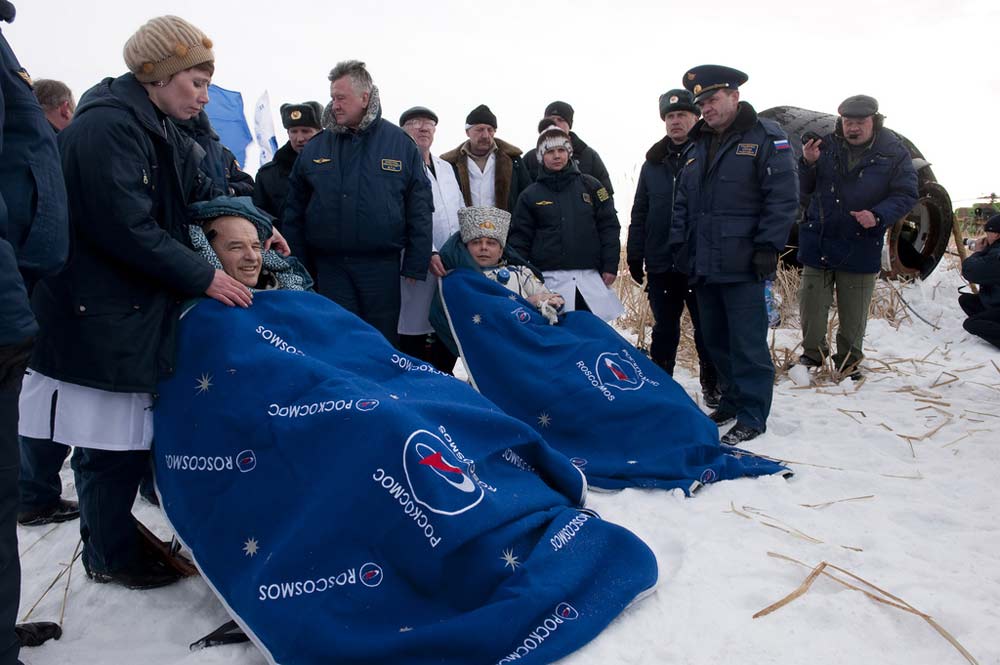Space Station Astronauts Make Frigid Landing in Soyuz Spacecraft

This story was updated 7:51 a.m. ET.
Two astronauts, one American and the other Russian, returned to Earth Thursday from the International Space Station and were greeted with freezing temperatures and snow at their Central Asian landing site.
Space station commander Jeffrey Williams, of NASA, and Russian flight engineer Maxim Suraev safely landed in snow on the frigid steppes of Kazakhstan at about 7:24 a.m. EDT (1124 GMT) in their Russian-built Soyuz TMA-16 spacecraft. It was about 5:24 p.m. Local Time at the landing site, where the astronauts met with stiff winds and temperatures around 20 degrees Fahrenheit (minus 6 degrees Celsius).
The winds at the landing site rolled the Soyuz over on its side after it touched down, but that was expected and helicopters carrying standard recovery teams were quickly on hand to begin extracting the crew, NASA officials said.
NASA spokesperson Josh Byerly, who was at the landing site, said the Soyuz landed on its bottom in nearly 4 feet (1.2 meters) of snow, and was rolled over and dragged about 20 feet (6 meters) by the winds tugging on its main parachute. The snow prevented some all-terrain recovery vehicles from reaching the landing zone, but recovery helicopters were able to land as planned, he added.
The successful landing on the steppes northeast of the remote Kazakh town of Arkalyk ended a nearly six-month stay in space for Williams and Suraev.
"It's been quite a year," Williams said Wednesday before leaving the space station. "Transitioning to a crew of six, and we're still working out the kinks out, but I think overall it's been very successful."
Breaking space news, the latest updates on rocket launches, skywatching events and more!
Byerly said Williams and Suraev are in good spirits and gave hearty thumbs up signs after being extracted from their spacecraft.
The mission marked Williams' third trip to the space station and the first spaceflight for Suraev. They launched in September 2009 and spent 169 days in space during their flight.
While they were at the station, the orbiting laboratory received a new Russian docking port and hosted two visiting NASA space shuttle crews. They astronauts also helped install a new room and observation deck that offers stunning views of Earth from space during the most recent shuttle visit in February.
The 11-year-old space station even got a live Internet connection during their stay, allowing Williams to post Twitter updates himself (as Astro_Jeff) instead of asking Mission Control to do it for him. Suraev blogged about his flight in Russian for followers in his own country.
Williams and Suraev started out as flight engineers with the outpost's Expedition 21 crew. In December, Williams took command of the station's Expedition 22 crew, which included himself, Suraev and three other astronauts from Russia, the United States and Japan.
Before leaving the space station Thursday, Williams turned control of the outpost over to veteran Russian cosmonaut Oleg Kotov.
Kotov arrived at the space station in December alongside NASA astronaut Timothy "T.J." Creamer and Japanese astronaut Soichi Noguchi. The three men are currently the only station residents, but expect to double their crew size in early April, when a new Soyuz spacecraft is scheduled to arrive on April 4 carrying two Russians and an American.
Noguchi posted a photo via Twitter of his crewmates undocking from the space station shortly after the Soyuz TMA-16 departed. He was jubilant to hear of their successful landing.
"Soyuz TMA-16 successfully landed!" wrote Noguchi, who has been chronicling his space mission as Astro_Soichi.
It will be a particularly busy time for the space station crew. On April 5, just a day after the new station crew arrives, NASA plans to launch the space shuttle Discovery from Florida to deliver a cargo pod filled with new science gear and supplies to the orbiting laboratory.
That mission will be NASA's second of five final shuttle missions planned for 2010 before the shuttle fleet is retired in the fall.
Construction of the $100 billion space station began in 1998 and is now 98 percent complete. The space station has about 12 modules, or rooms, and the equivalent living space as the interior of a Boeing 747 jumbo jet.
The orbiting laboratory's exterior truss and wing-like solar arrays stretch across an area as long as a football field. The station can easily be seen from Earth by the unaided eye on clear nights.

Tariq is the award-winning Editor-in-Chief of Space.com and joined the team in 2001. He covers human spaceflight, as well as skywatching and entertainment. He became Space.com's Editor-in-Chief in 2019. Before joining Space.com, Tariq was a staff reporter for The Los Angeles Times covering education and city beats in La Habra, Fullerton and Huntington Beach. He's a recipient of the 2022 Harry Kolcum Award for excellence in space reporting and the 2025 Space Pioneer Award from the National Space Society. He is an Eagle Scout and Space Camp alum with journalism degrees from the USC and NYU. You can find Tariq at Space.com and as the co-host to the This Week In Space podcast on the TWiT network. To see his latest project, you can follow Tariq on Twitter @tariqjmalik.
